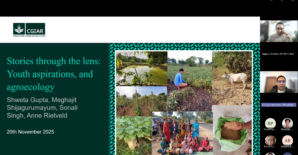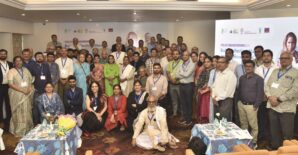ASEAN Economic Community Blueprint 2025 is in the implementation phase, succeeding the previous 2008-2015 Blueprint. It is progressing through the implementation of the priority economic deliverables under Thailand’s Chairmanship in 2019. What is the Agriculture sector position in this phase?
 The Agricultural Transformation and Market Integration in ASEAN region: Responding to Food Security and Inclusiveness Concerns project (ATMI-ASEAN) organized a regional workshop cum roundtable discussion on ASEAN Economic Integration in Bangkok, Thailand on 28-29 November 2019. It discussed ASEAN agricultural market integrations and value chain competitiveness in support of the broader goal of achieving competitive ASEAN economies.
The Agricultural Transformation and Market Integration in ASEAN region: Responding to Food Security and Inclusiveness Concerns project (ATMI-ASEAN) organized a regional workshop cum roundtable discussion on ASEAN Economic Integration in Bangkok, Thailand on 28-29 November 2019. It discussed ASEAN agricultural market integrations and value chain competitiveness in support of the broader goal of achieving competitive ASEAN economies.
The ATMI-ASEAN project is funded by the International Fund for Agriculture Development (IFAD), led by IFPRI in collaboration with the Southeast Asian Regional Center for Graduate Study and Research in Agriculture (SEARCA).
The two-day workshop cum roundtable discussion attended by the ATMI-ASEAN national project focal points and researchers from Cambodia, Lao PDR, Myanmar, Viet Nam, and the Philippines, academes from Indonesia, Malaysia, Thailand, trade expert from Singapore, Grow Asia, the Asian Farmers Association (AFA), Development of Human Resources in Rural Asia (AsiaDHRRA), the ASEAN Plus Three Emergency Rice Reserve (APTERR), SEARCA, IFAD, and IFPRI.
Day one covered presentations of project experts and country's agricultural marketing systems in five ASEAN countries. While day two comprised discussions on foreign direct investment in Singapore, trade policy and standards in other four ASEAN countries, and the ASEAN Guidelines on Promoting Responsible Investment in Food, Agriculture, and Forestry (ASEAN RAI).
IFPRI’s Senior Research Fellow, Dr. Hiroyuki Takeshima, shared the findings from his study on Agricultural transformation, market integration, and smallholders in Southeast Asia: a regional overview and micro evidence from Viet Nam. He found that the agricultural production within the ASEAN region remains a primary food and nutrition source despite increasing ASEAN extra trade. ASEAN agriculture transformation has been, somewhat faster than South Asia region, in terms of labor movement out of the agricultural sector in countries like in Viet Nam, more integration with food market, particularly through increased food purchase, has been associated with greater diversification among smallholder households and greater female labor participation in the non-farm sector.
While both, the ASEAN region and the SAARC region are the two largest trading blocs in Asia, Dr. Devesh Roy IFPRI's Senior Research Fellow argued that no recorded studies are available on the agriculture food trade performance between these regions. His presentation was based on the ongoing research under the project, to assess the agriculture food trade performance between the ASEAN and SAARC region, and China.
The ATMI-ASEAN national project researchers shared findings from the project’s national study in their country. Mr. Sorn Vichet of Ministry of Agriculture, Forestry and Fisheries of Royal Cambodia, Dr. Phonevilay Sinavong of the National Agriculture and Forestry Research Institute (NAFRI) of Lao PDR, Ms. Nang Seng Pin of the Centre for Economic and Social Development (CESD) of Myanmar, Ms. Bui Thi Viet Anh of the Institute of Policy and Strategy for Agriculture and Rural Development (IPSARD) Viet Nam, and Mr. Christian Paul Fang of the University of the Philippines Los Baños (UPLB) presented agricultural marketing systems and trade of maize in Cambodia,and Lao PDR, pulses in Myanmar, pig in Viet Nam, and agriculture and processed pork in the Philippines, respectively.
Prof. Muhammad Firdaus of IPB University presented that the ASEAN region has a potential trade market due to its size. The ASEAN Gross Domestic Product (GDP) is ranked 7th and the 3rd number in the world and Asiarespectively. However, the intra-trade ASEAN is only 23.21% compared to the extra-trade ASEAN. Indonesia and Thailand receives maximum benefits of AEC. Indonesia only imposes the non-tariff measures (NTMs) which makes it a huge market for agriculture products.
Malaysia’s agricultural products contributed to 13.5% of the total export and 10.4% of the total imports in 2017. While Indonesia’s trade restriction according to Prof. Firdaus is only NTMs, tariff in Malaysia is reviewed every year as part of the national budget process according to Dr. Nolila Mohd Nawi of University Putra Malaysia (UPM). However, it is reduced between 0-15% for ASEAN countries’ products, depending on its categories.
To ensure food security, Singapore maintains a generally liberal and open trade system, according to Ms. Maria Esperanza F. Alconcel, an independent consultant and international trade expert based in Singapore. There are no quotas and tariffs imposed on imported food and agricultural products, to facilitate agri-trade to Singapore, except for tobacco and alcoholic beverages. Singapore imposes strict food standards, to ensure food safety and quality.
Dr. Isriya Bunyasiri of Kasetsart University (KU) presented the agro-food trade of Thailand. The world trade organization (WTO) data shows that Thailand has maintained 2% of the world's exports of agricultural products. An increased number of free trade agreements (FTAs) has broadened Thailand's export markets. Thailand applies 330 agricultural standards; six standards are mandatory, and the rest are voluntary. The government protects rice farmers through the domestic price support program. The farmer receives cash compensations once the rice market prices are under the guaranteed prices.
Dr. Shih-Hsun Hsu of National Taiwan University (NTU) shared an interesting video on how the Taiwan government helps farmers on marketing their agriculture products. He explained that only 23% of land in Taiwan are suitable for agriculture. Taiwan’s export of agricultural products has continued to increase, driven by rapid growth in the Asia region. AMS has abundant resources and labor for the agriculture industry, however, they lack capital and technology. While Taiwan, on the contrary, has many world-leading technologies for tropical agriculture but has insufficient resources and aging labor.
Ms. Alconcel presented Singapore’s foreign direct investments. She shared that with global trade tensions, Singapore receives new foreign investments as supply chain points from UK, EU, and Japan. Singapore promotes as a regional hub for the ASEAN region. ASEAN companies invested $3.4 billion in agriculture and forestry in 2018. Indonesia received more than 80% of FDI agriculture and forestry came from 94% companies based in Singapore. Singapore creates a conducive environment for companies.
Ms. Erin Sweeney of Grow Asia and Ms. Maria Elena Rebagay of AFA presented the ASEAN RAI and their perspectives. It was adopted at the 40th meeting of the ASEAN Ministers on Agriculture and Forestry (AMAF) to provide recommendations for responsible investments in Agriculture and Forestry sectors in the ASEAN region.
At the end of the workshop, a stocktaking discussion to select commodities for the regional roadmap exercise was organized, as an input at the 2nd ATMI-ASEAN Regional Project Steering Committee (RPSC) Meeting on 30 November 2019.
Aniq Fadhillah is a Policy Facilitator for Agricultural Transformation and Market Integration in ASEAN Region: responding to Food Security and Inclusiveness Concerns (ATMI-ASEAN project).
More information about the ATMI-ASEAN project.
News on SEARCA’s web.



